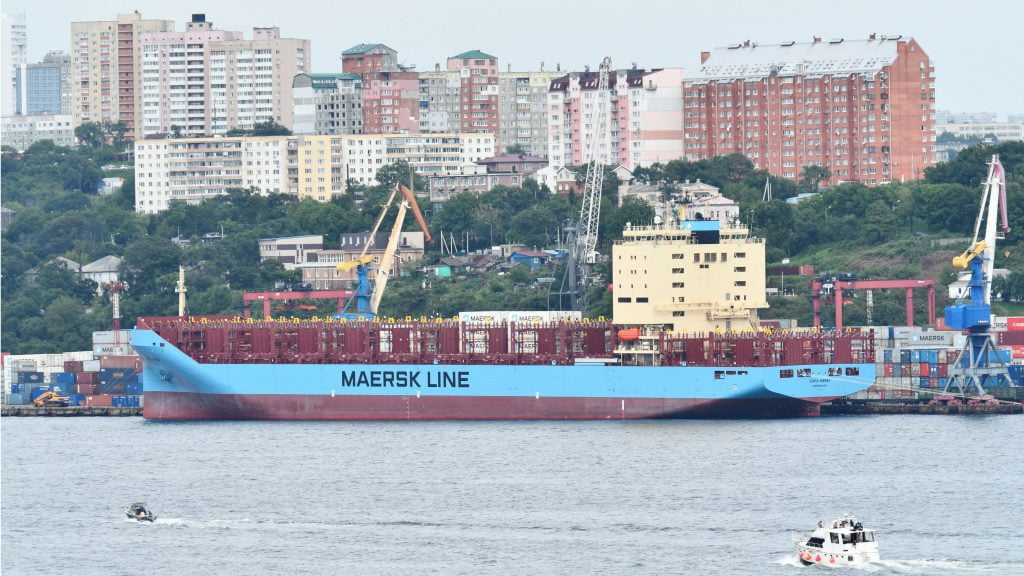Interestingly, a combination of a Danish transport company, Chinese shipbuilding and Russian clients have put together the next phase of global transit. A Maersk ship has left Asia bound for Russia through the Northern Passage.
“A brand new ice-strengthened containership is heading straight into the annals of maritime history. As the first containership ever Venta Maersk is on its way through the still ice-plagued North East passage north of Russia from Asia to Europe.
“Venta Maersk belongs to Seago Line, a shipping company owned by Denmark’s A.P. Moller Maersk A/S, the world’s largest container-shipping agency.”
This development was highlighted in an article by Martin Breaum in an an article published by the EUObservor on September 17, 2018.
Venta Maersk is the first of seven ice-strengthened container ships being built in China for Maersk.
The first stop in Europe will be in Bremerhaven, Germany before continuing on to St. Petersburg.
“Venta Maersk is a signal to COSCO (the Chinese shipping company), who has been the most active player in the North East Passage,” says a Danish industry source, who askedfor anonymity.
“Maersk illustrates that they are ready for it and that they have the ships for it. This is about being prepared. Maersk has found its inner Viking. They do not any longer focus only on growth and on reducing costs but also look offensively at new opportunities,” this source told EUobserver.
Increased political instability in the world also plays a role, he thinks: “In such a situation it is good commercial thinking to be first-movers. There is war on the Horn of Africa where we had the pirate challenge. We have seen terrorist groups block the Suez canal. The Strait of Mallaca may also quickly turn into a bottleneck. In this state of affairs it might be really nice to have an alternative like the North East Passage, if everything else closes”.
No-one in the industry expects the North East Passage to ever rival the route through the Suez canal as the main artery for cargo between Europe and Asia, but many now see the North East Passage as a potentially important niche for the industry.
In a story by Atle Staalesen published by The Independent Barents Observer dated September 12, 2018, further details were provided on the voyage of the new ship.
With a speed of 11 knots the Venta Maersk sailed through the most difficult part of the Northern Sea Route, in the Russian Arctic.
The brand new container ship designed for voyages in icy conditions in late August set out from Busan, South Korea, and was from 8th September accompanied by nuclear icebreaker 50 let Pobedy through the East Siberian Sea and Laptev Sea (Russian east-Arctic).
It is said to be the first regular container ship that has crossed the Russian Arctic route.
The icebreaker escort was completed as the ships had sailed into the Laptev Sea on the 11th September, nuclear power company Rosatom informs (in Russian).
Ice data from the Russian Arctic and Antarctic Research Institute show that there is still more than one-meter thick ice in major parts of the East Siberian Sea, while the whole Kara Sea and practically all of the Laptev Sea is ice-free.
“The convoy successfully proceeded through the Sannikova Strait, which is the shortest route, with an average speed of 11 knots”, says Rosatom Chief of maritime operations Vladimir Artyunyan.
The Venta Maersk is now independently continuing its voyage towards its end destination of Bremerhaven in Germany. It will proceed through the Laptev Sea, and subsequently the Kara Sea (Russian Arctic) and Barents Sea (European Arctic) before it enters Norwegian waters.
The featured photo shows the Venta Maersk in the port of Vladivostok (Russian far-east) as it prepares to set off for the Northern Sea Route, on August 22, 2018. (Yuri Maltsev/Reuters)


